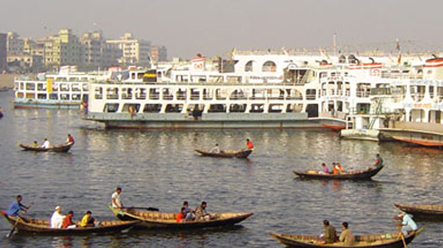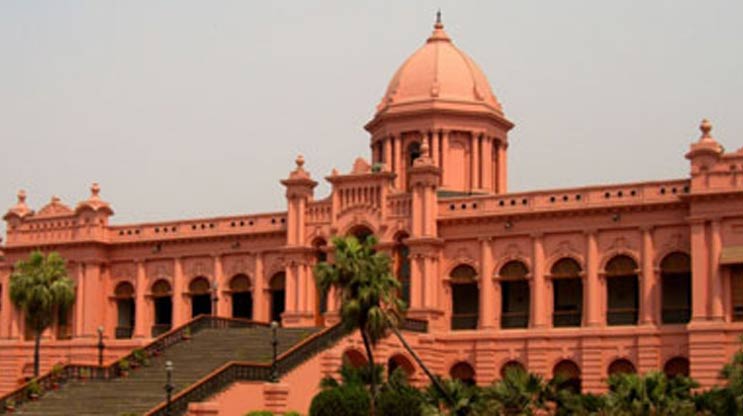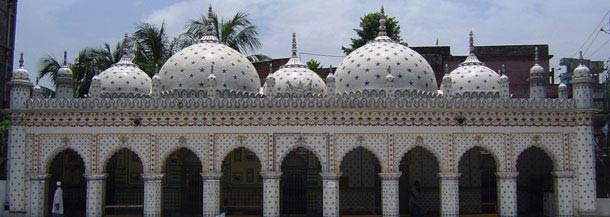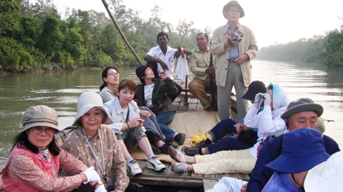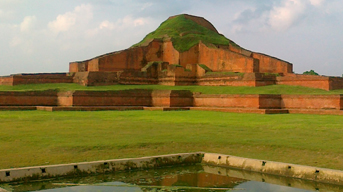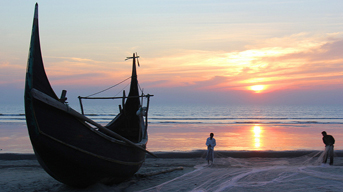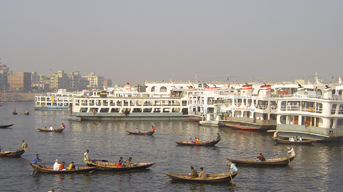Lalbagh Fort:
Lalbagh Fort or Fort Aurangabad is an incomplete Mughal palace fortress at Dhaka on the river Buriganga in the southwestern part of the old city. The river has now gone further south and flows at quite a distance from the fort. The construction of the fort was commenced in 1678 AD by Prince Muhammad Azam during his 15 month long vice-royalty of Bengal, but before he could complete the work he was recalled by Aurangzeb. His successor, Shaista Khan did not continue the work, though he stayed in Dhaka up to 1688. His daughter Bibi Pari (Lady Fairy) died here in 1684 and this led him to consider the fort to be ominous.
Dhakeshwari Temple:
Dhakeshwari National Temple is a famous Hindu temple in old Dhaka and is state-owned, giving it the distinction of Bangladesh's "National Temple". The name Dhakeshwari means "Goddess of Dhaka". It hosts the yearly Puja (worship) of the goddess Durga. Inside the main temple premises, there are four identical structures devoted to the god Shiva. To the east of these is the main temple, which hosts the statue of the goddess.Popular legend connects the name of one king, Ballalsena, as its builder, but it is not certain that he is identical with the 12th century Sena king of that name. The style of architecture of the temple cannot be assigned to that period. However, it must be said that there is another explanation of the name. The deity was found hidden underneath the earth and hence the name. Legends ascribe the construction of the temple to Ballalasena, the Sena king, who found the deity and constructed a temple for it.Thus it appears that the origin of the Dhakeshwari temple is shrouded in mystery. In the beginning of the 20th century Bradley Birt wrote that the temple is more than 200 years old and a Hindu agent of the East-India Company built it.
Curzon Hall:
The magnificent double-storied building in red bricks with a blend of continental and Mughal architecture, with cusped arches and kiosk-like turrets, was built in 1904 as a Town Hall for the newly created province of East Bengal and Assam. A year later, Bengal was partitioned and Dhaka became the capital of the newly created province. It was named after LORD CURZON, the Viceroy of India, who laid its foundation. Following the annulment of partition in 1911 it was used as a premise of Dhaka College, and after the establishment of Dhaka University in 1921, became part of the university's science section and continues as such.
One of the best examples of Dhaka's architecture, it is a happy blend of European and Mughal elements, particularly noticeable in the projecting facade in the north which has both horse-shoe and cusped arches.
The Curzon Hall has attained a great significance in the history of the Language Movement. It was here, in 1948, the students of Dhaka University uttered their first refusal to accept Mohammad Ali Jinnah's declaration that Urdu alone would be the state language of the then Pakistan.
National Museum:
Bangladesh National Museum preserves and displays the cultural property and heritage, as well as specimens of natural history of Bangladesh.
The Bangladesh National Museum was shifted to its present site at Shahbag on 17 November 1983. The four-storied building of the museum has 43 galleries on a total floor space of 238,000 square feet. By June 1998, the museum had collected 82,475 objects. The most significant objects are: ancient petrified wood (2.5 million years old), Blackstone Naga Darwaza (serpent doorway) of 10th-11th century, pieces of atom bombs blasted in Hiroshima and Nagasaki, Japan in 1945; mat made of ivory; objects of the Liberation War of Bangladesh; objects used by the martyrs of the Language Movement, Muslin of Dhaka; items of folk art and crafts; coins of ancient period, terracotta plaques; sculptures and collection of contemporary art including various types of statues.
National Parliament Building:
National Parliament Building is one of the majestic public buildings. The Sangsad Bhavan complex is located at Sher-e-Bangla Nagar of Dhaka city. National Assembly Building is an architectural masterpiece for which the nation is proud of.
Starting from the beginning of architectural history, say from the time of the Pyramids till modern times, if a list of most significant buildings of the world is made, the National Assembly building complex will feature very prominently among the top few in that list. It can be said to be the culmination of the modern period of architecture and the beginning of that of the post-modern era. This magnificent building stands as a silent evidence of the creative devotion and poetic vision of its American architect, Luis I Kahn.
The work of the National Assembly building was completed in early 1982, and was inaugurated on 28 January 1982. The inaugural session of the National Assembly commenced in this building on 15 February 1982.
National Marty's Monument:
National Martyrs' Memorial situated at Savar, about 35 km north-west of Dhaka, symbolizes the sacrifice of the martyrs who sacrificed their lives for the liberation of Bangladesh.
A national competition was held for the design of the project in June 1978. Among the fifty-seven competitors Architect Syed Moinul Hossain's design proposal was selected.
The monument is composed of 7 isosceles triangular pyramid shaped structures, with the middle one being the tallest. The highest point of the monument is 150 feet. There is an artificial lake, and several mass graves in front of the main monument
The whole complex is spread over an area of 34 hectares (84 acres) which is again wrapped around by a green belt of 10 hectares (24.7 acre). Several mass-graves and a reflection water body are placed in front of the monument. Once one enters the complex through the main gate he or she can see the monument axially but to reach it one has to walk through different ups and downs of pavements and cross an artificial lake by a bridge-all these represent the struggle for independence.
Shaheed Minar:
The Shaheed Minar is a national monument in Dhaka, Bangladesh, established to commemorate the martyrs of the Language Movement of 1952.
On February 21, 1952, dozens of students and political activists were killed when the Pakistani police force opened fire on Bengali protesters who were demanding equal status to their native tongue, Bangla. The Language Movement gained momentum and after a long struggle, Bangla was given equal status as Urdu. To commemorate the martyrs, the Shaheed Minar was designed and built by Hamidur Rahman, a Bangladeshi sculptor.
Today, the Shaheed Minar is the centre of cultural activities in Dhaka. Every year, the Language Movement is remembered at the monument.
Sonargaon:
The administrative centre of eastern Bengal under the Muslim rulers of Bengal survives at present in the name of an upazila in the Narayanganj district and the 'golden village' (its literal meaning) is now a township about 27 kilometers to the southeast of Dhaka. It is difficult to locate exactly the medieval city, but from the extant remains it appears to have embraced a wide tract bounded on the east, west and south by the Meghna, the Shitalakhya and the Dhaleshwari respectively and on the north by the Brahmaputra.
From the capture of Sonargaon by Shamsuddin Iliyas Shah (1352) down to the coming of the Mughals it was a provincial metropolis except for a period when it became a capital city under the house of Isa Khan. After the fall of Musa Khan (1611), Sonargaon became one of the sarkars of the Mughal subah of Bengal. With the establishment of the Mughal capital at Dhaka, Sonargaon must have fallen fast into decay.
By the second quarter of the fourteenth century Sonargaon developed into a commercial metropolis; seafaring boats could easily reach Sonargaon from west Asian and southeast Asian countries. Ibn Batuta describes Sonargaon as an important port city which had direct commercial relations with countries like China, Indonesia (Java) and the Maldives.
Famous Muslin of Sonargaon had a worldwide reputation. With the loss of political status in the second decade of the seventeenth century Sonargaon gradually lost its commercial importance as well.
Panam City:
Panam City was developed during the British period at Sonargaon, the capital of the independent Sultanate of Bengal around the 13th century. The buildings were initially constructed by Hindu landlords and merchants towards the end of the 19th century and the beginning of the 20th century on both sides of the Grand Trunk Road, built in the 16th century.
Panam is widely known as Haveli-Sonargaon surrounded by a trench and connected by the three brick bridges-Panam Bridge, Dalalpur Bridge and Panamnagar Bridge-belonging to the Mughal period. The buildings, mostly two- or three-storey high, are made of lime and brick. They vary in their design of verandahs, balconies and a porch.
The decorative treatments were transposed from the European architecture and blended with the local motifs, which still attract tourists. Panam was taken over by the Department of Archaeology of the ministry of cultural affairs, under the Antiquities Act 1968.
Goaldi Mosque:
This mosque is one of the few remnants from the Sultanate period in Sonargaon, about six km northwest of the little township of Panam. According to an inscription, it was built by Mulla Hizabar Akbar Khan on 15 Shaban in 925 AH/ August 1519 AD, during the reign of Sultan Alauddin Husain Shah. This mosque is more elegant and ornate in comparison to the earlier Sultanate mosques at Bagerhat. Each wall has three arched entrances, the central arch slightly higher than the others. A single graceful hemispherical dome rises above the slightly curved cornice. Miniature arches with terracotta designs are placed below the cornice and above the entrance arches. Round corner turrets that rise up to the cornice and have two moldings at the centre and triple moldings at the base, just above which are more terracotta arches.
Sonargaon Folk Art Museum:
Zainul Abedin, the great artist of Bangladesh selected Sonargaon to establish Folk Arts and Crafts Museum. As a result, the Government of Bangladesh established the Bangladesh Folk Arts and Crafts Foundation on March 1975. There are two museums with 13 galleries in this foundation. One is Folk Art and Crafts museum and the other is Shilpacharya Zainul Abedin museum. Every year the Foundation arranges month-long folk fair and folk festival. Thousands of people enjoy the festival. With different motifs and colors, Jamdani and Nakshi Kantha are projected here. The main objectives of the Foundation are to collect, preserve, and display, carry out researches and revitalize traditional folk arts and crafts of Bangladesh.
